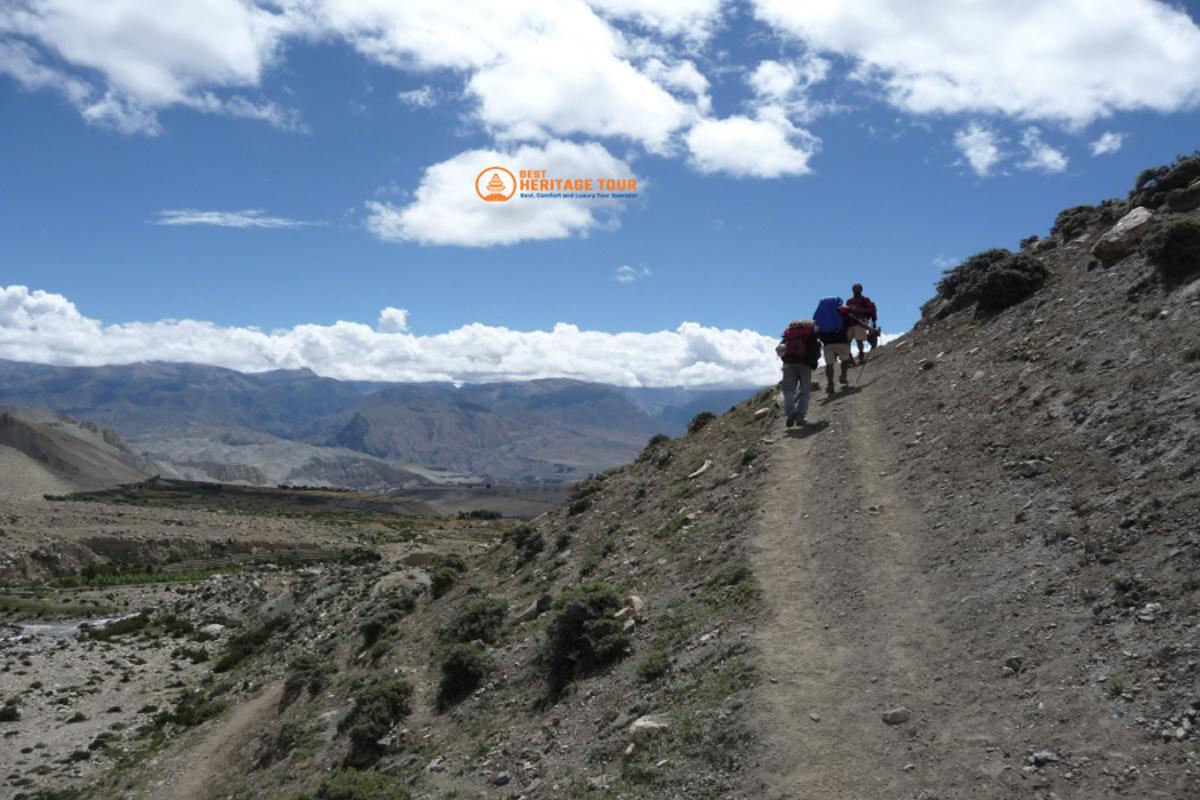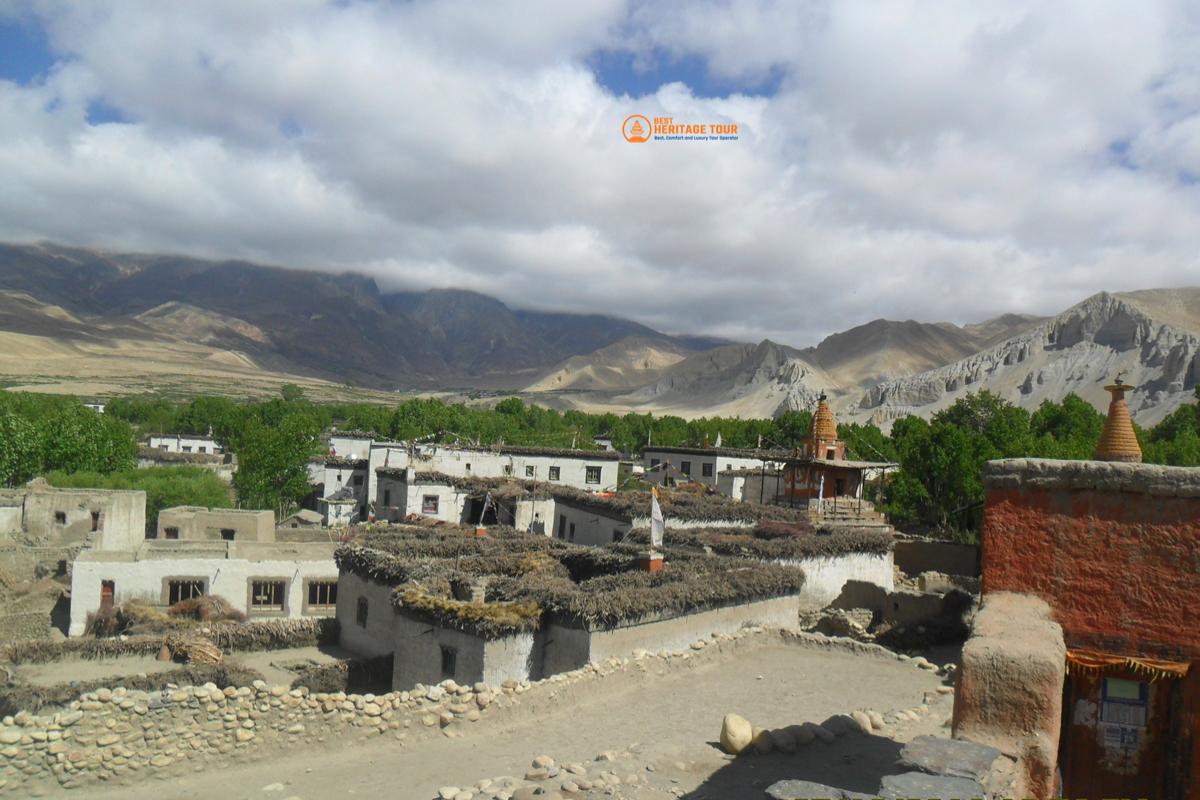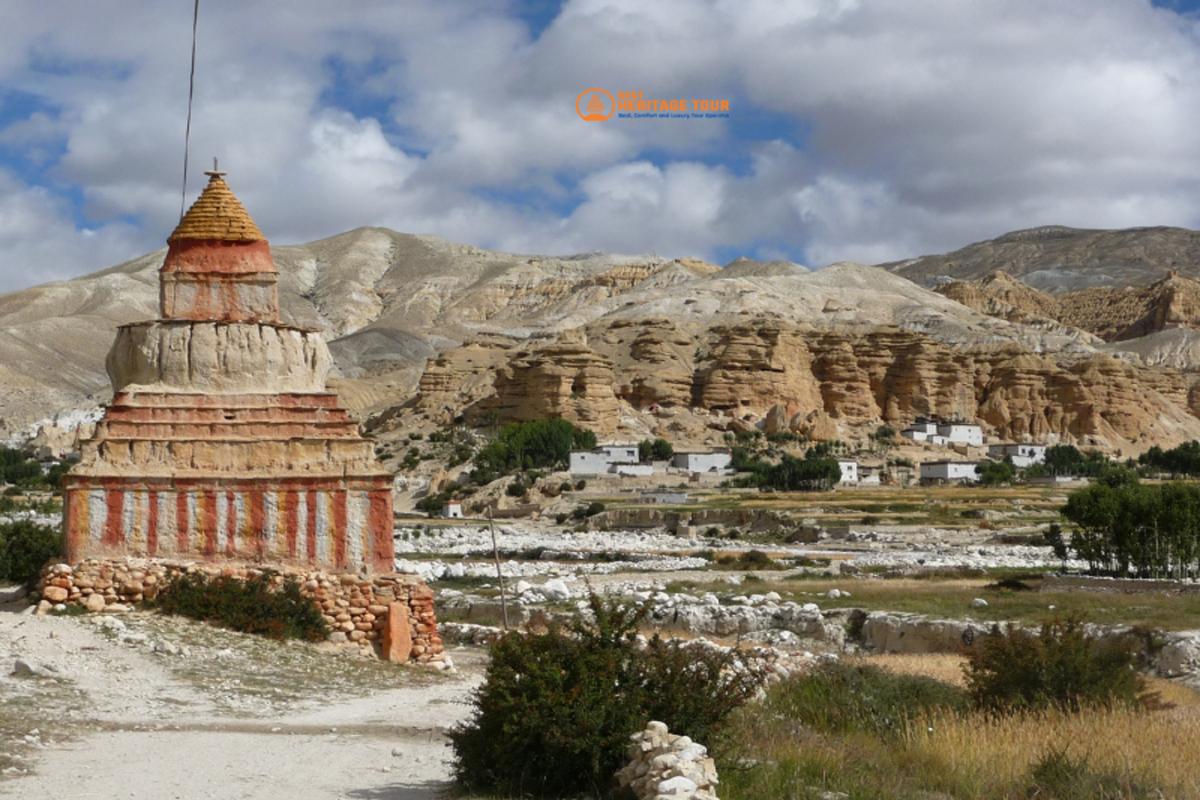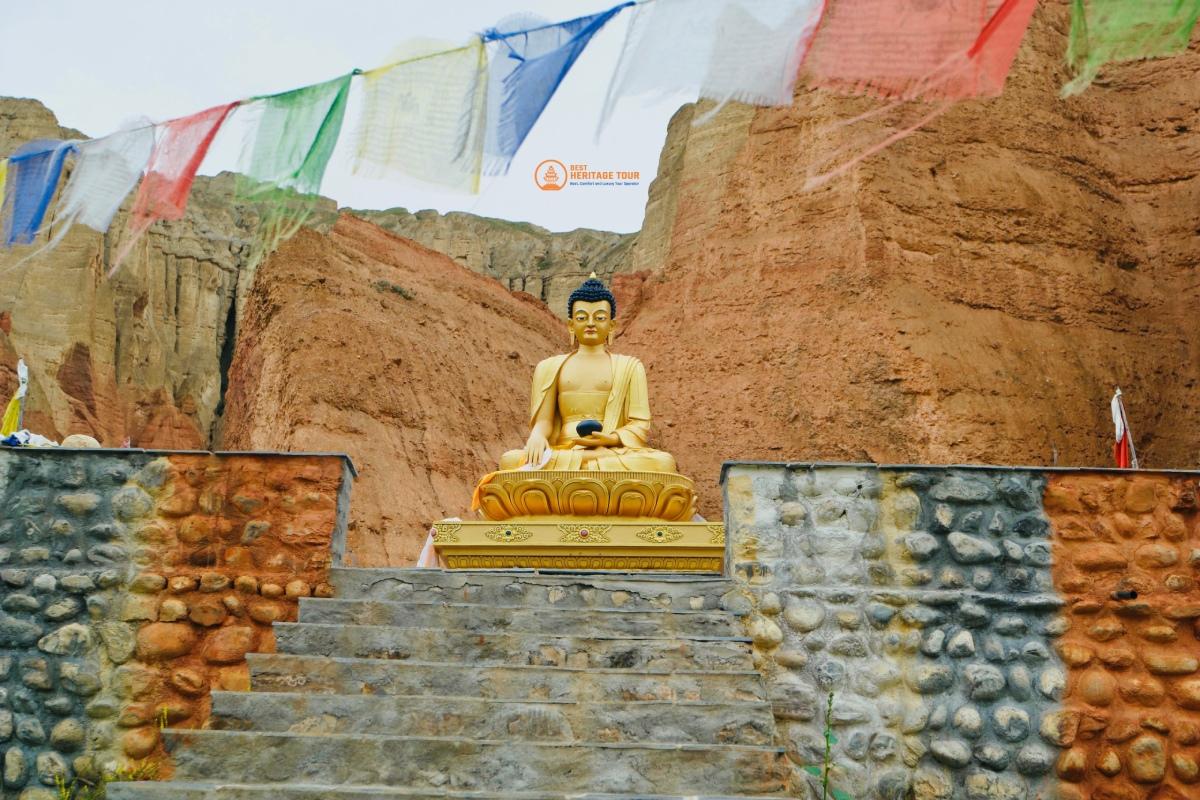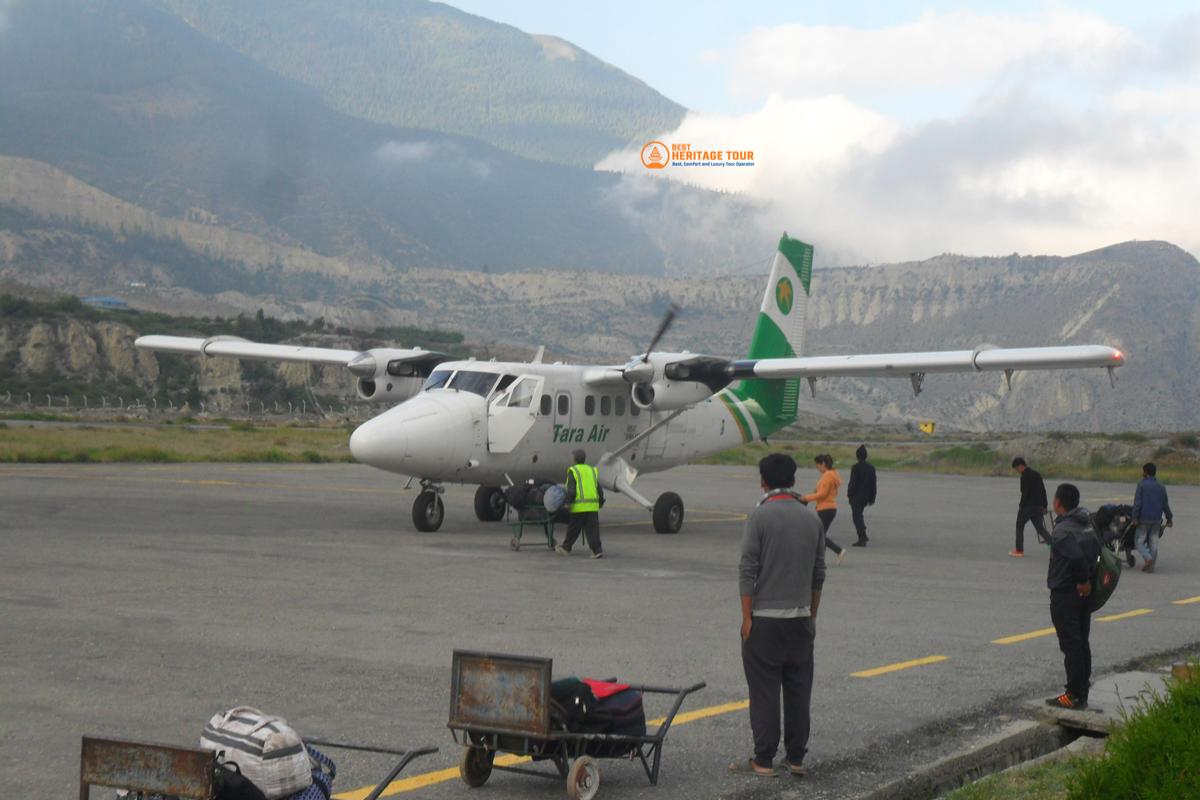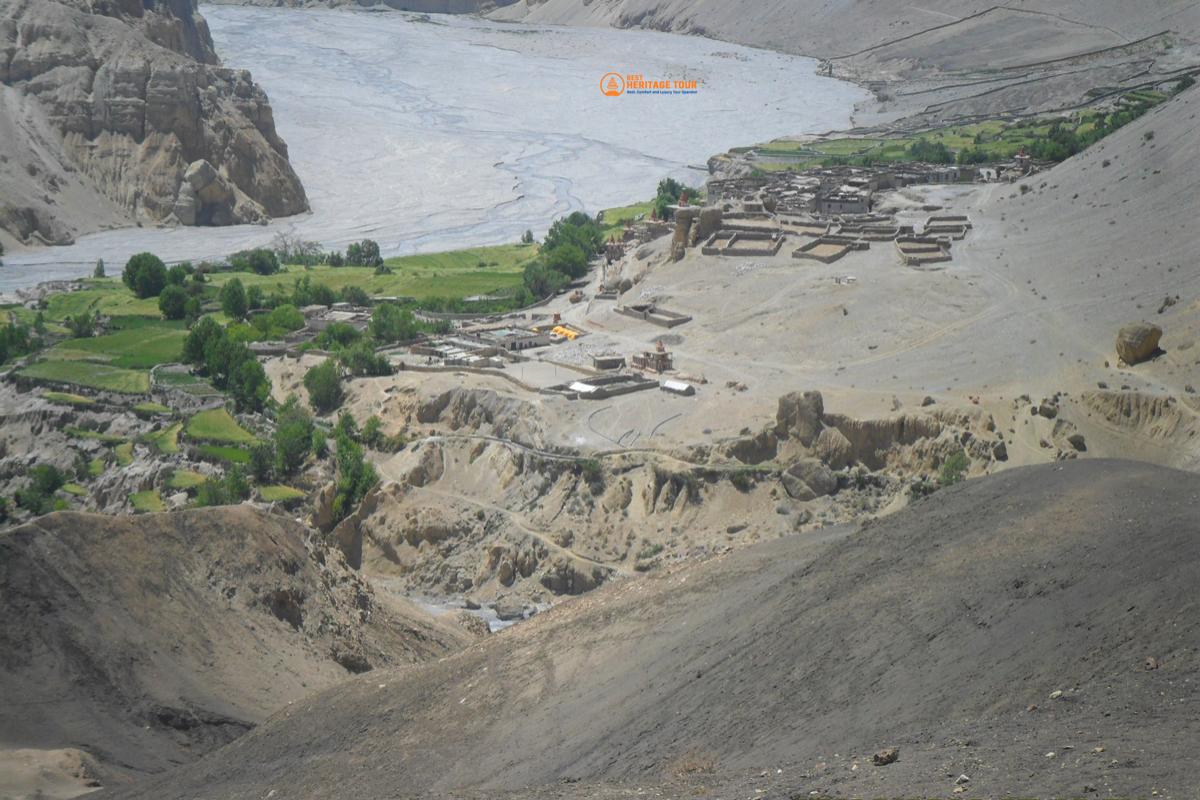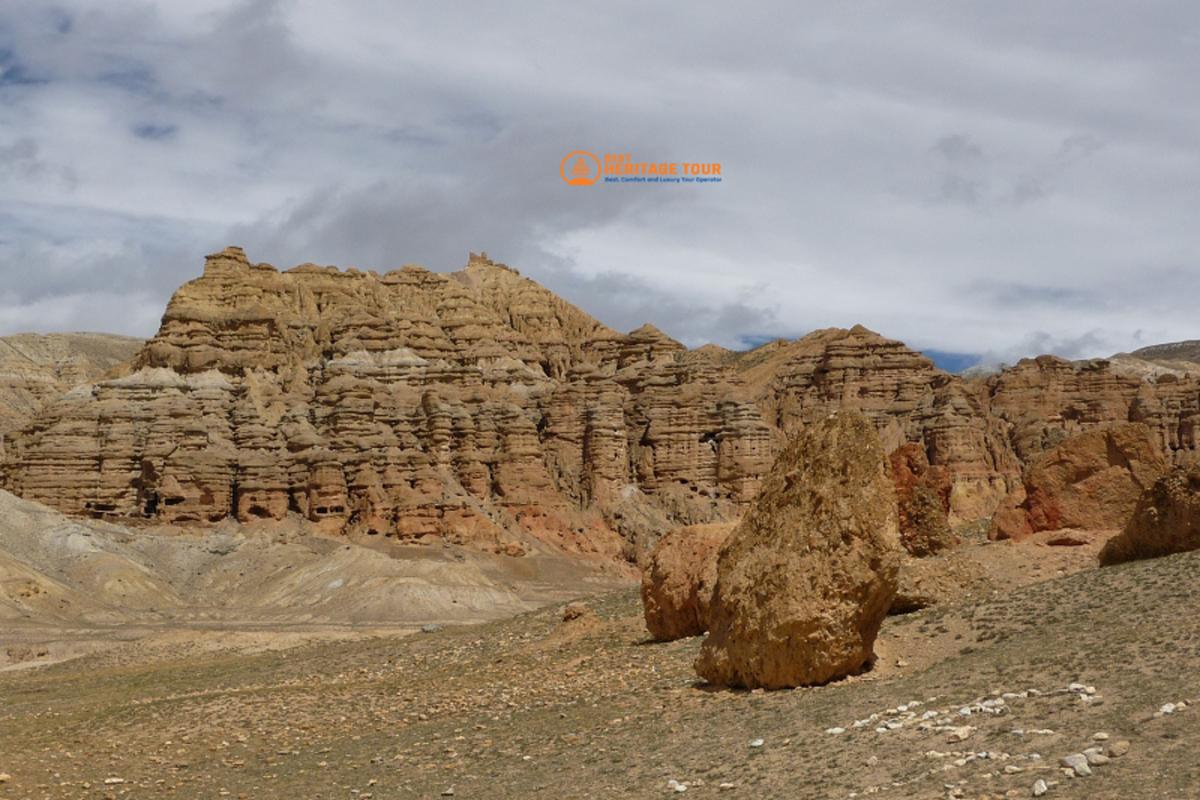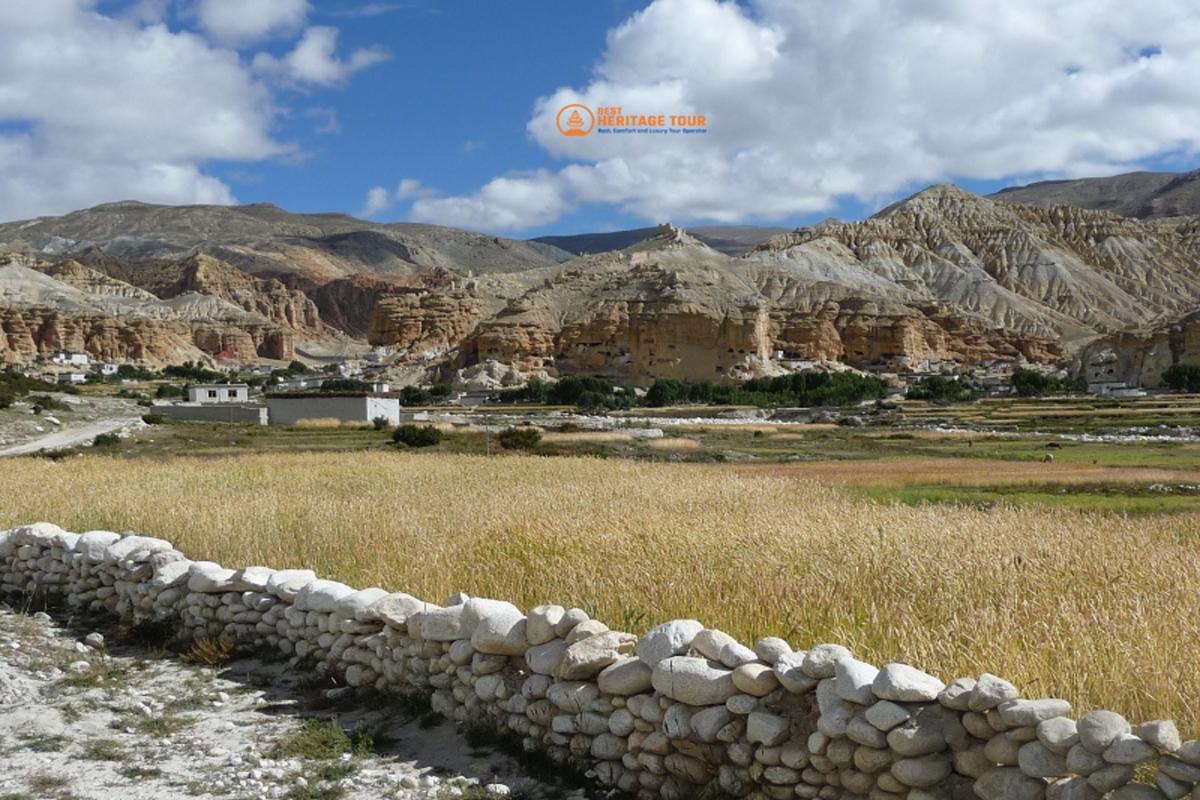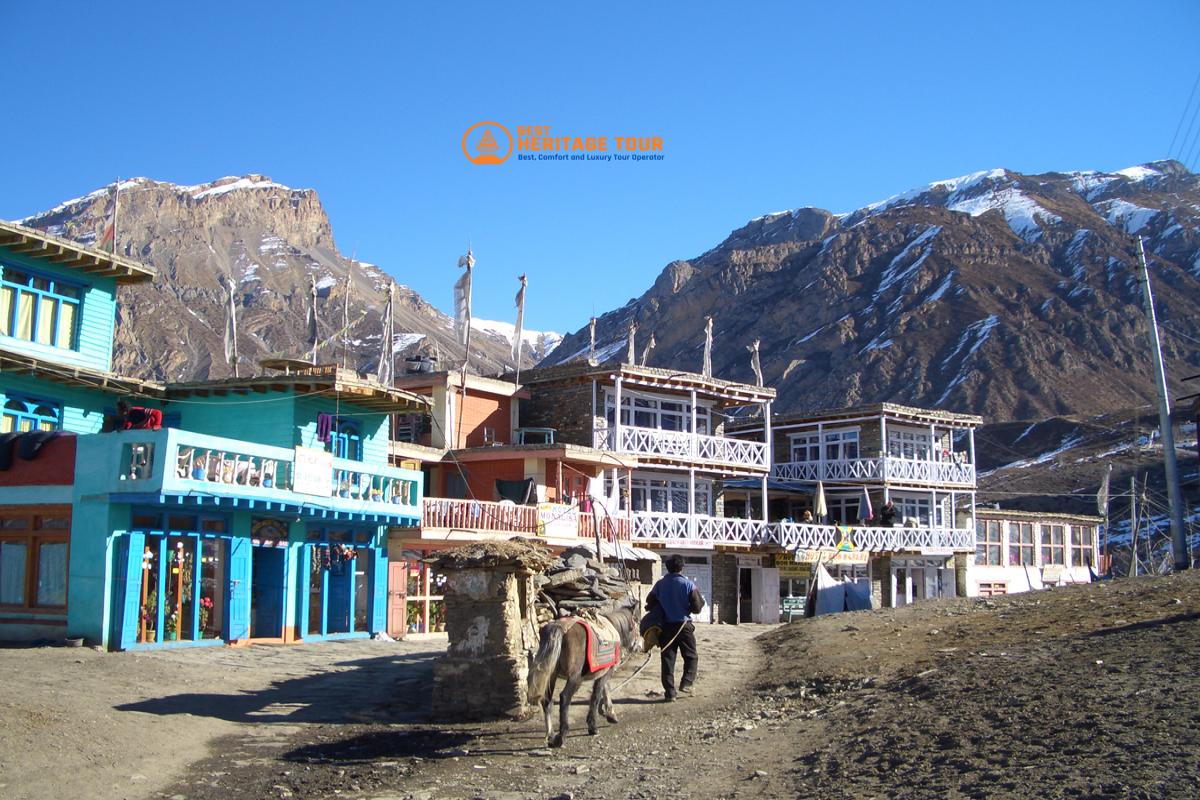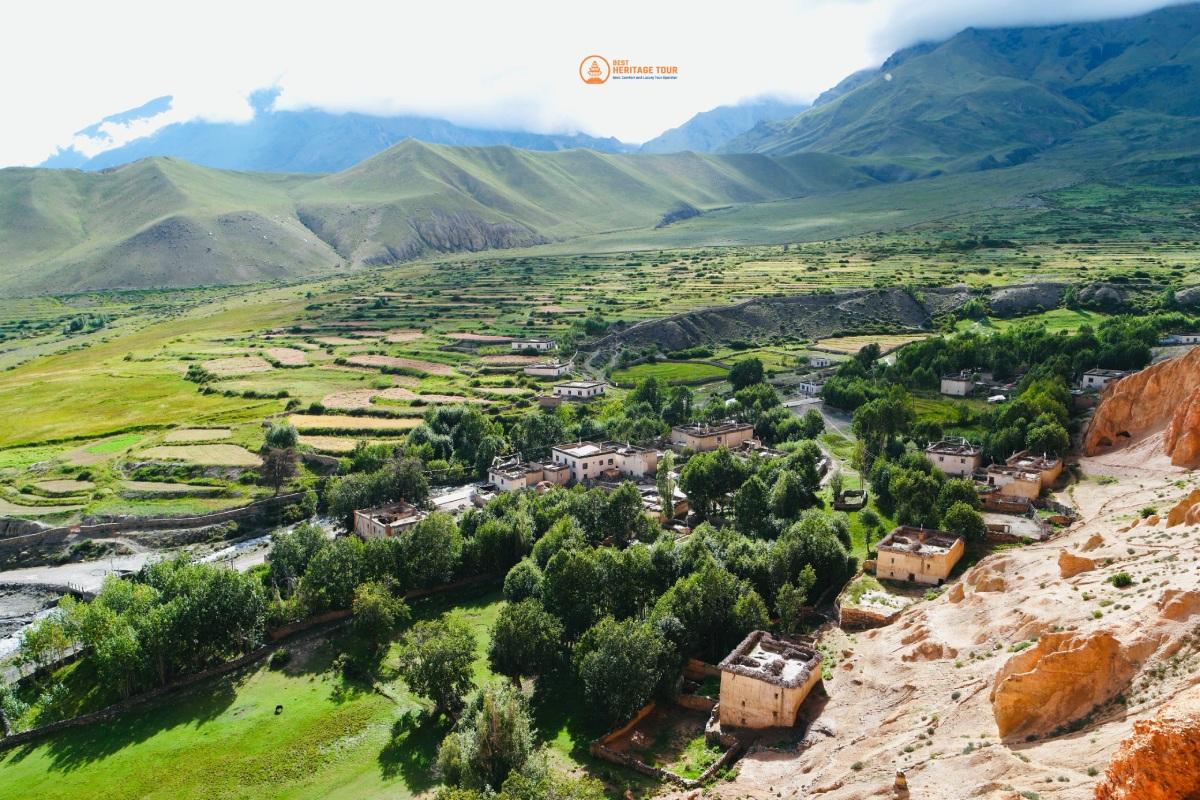Upper Mustang lomanthang Trek - 15 days
Insight on Upper Mustang Trek
Upper Mustang, located in the rain shadow of the Himalayas near the Annapurna region, is a unique desert-like valley that was once a forbidden kingdom of Nepal. Isolated for decades, it has preserved its distinct culture, traditions, and Tibetan-influenced lifestyle. Trekkers can explore ancient walled towns, monasteries, and remote villages while enjoying dramatic landscapes of red cliffs, canyons, and barren deserts. With clear skies, stunning mountain views, and rich cultural heritage, Upper Mustang offers a one-of-a-kind trekking experience in Nepal.
Trip at a Glance
Key Highlights
- Visit Jomsom, the gateway and capital of the Mustang region.
- Explore Lo Manthang, the walled capital of the ancient Mustang kingdom.
- Enjoy breathtaking views of Annapurna, Dhaulagiri, Nilgiri, Torung Peak, Chulu West & East, Mt. Tukche, Lamjung Himal, Annapurna II & IV.
- Walk through yak pastures, lakes, glaciers, valleys, waterfalls, and desert-like landscapes.
- Visit Muktinath, a sacred site revered by both Hindus and Buddhists.
- Immerse yourself in Mustang culture, meet locals, and visit ancient Buddhist monasteries.
- Explore traditional Mustang villages, experiencing local customs, crafts, and lifestyle.
- Discover ancient trade routes and Tibetan-influenced architecture, offering a glimpse into the region’s history.
Benefits of Upper Mustang Trek with Best Heritage Tours
- Complimentary transfers are provided from the airport to your hotel upon arrival and for your departure.
- Easy booking and payment system
- We offer a variety of communication channels, including email, WhatsApp, Facebook, WeChat, Viber, Skype, and Zoom, to ensure seamless connectivity.
- 24/7 phone contact: +977- 9851149197/ +977-9810043046
- Pulse oximeter to monitor blood oxygen saturation and detect early signs of altitude sickness at high altitude
- Medical equipment in case of emergency
- Provide sleeping bags and trekking poles for those who may not have their own.
- Free excess baggage storage at BHT store during the trek
Trip Overview
The Upper Mustang trek takes you to the remote and fascinating “Forbidden Kingdom” of Mustang, a region that remained isolated for centuries and developed a unique culture and traditions similar to Tibet. Nestled in the rain shadow of the Himalayas, this area offers striking desert-like landscapes, dramatic cliffs, ancient caves, and sacred Buddhist sites. Lo Manthang, the historic capital, is a small walled town with monasteries, palaces, and traditional houses. The trek is also within the Annapurna Conservation Area, providing spectacular views of mountains such as Dhaulagiri (8,167m), Annapurna I (8,091m), and Nilgiri.
The journey begins with a scenic drive from Kathmandu to Pokhara, passing terraced fields, traditional villages, and rushing rivers. In Pokhara, you can enjoy the views of lakes and Himalayan peaks, including Dhaulagiri, Manaslu, and Lamjung Himal. From there, you fly to Jomsom, the gateway to Upper Mustang, where the trek officially begins.
From Jomsom, the trek passes through Kagbeni, the entrance to Upper Mustang, and continues to Chele, Syangboche, Gami, Tsarang, and finally Lo Manthang. Along the way, trekkers experience desert-like landscapes, high passes like Yamda La, traditional villages, and ancient monasteries. The trek also takes you to spiritual sites such as Muktinath, a revered destination for both Hindus and Buddhists.
After exploring Lo Manthang, the return journey retraces through Gami, Samar, Chusang, and Muktinath before descending to Jomsom. From there, an early morning flight brings you back to Pokhara, where you can either spend a day exploring the city or continue back to Kathmandu. The Upper Mustang trek combines cultural immersion, stunning landscapes, and a journey through one of Nepal’s most unique and remote regions.
What to Expect on Upper Mustang Trek
1. Desert-like Himalayan Landscapes
Trek through the unique rain-shadow region of Upper Mustang, where barren cliffs, deep canyons, and golden-red desert-like terrain create a surreal Himalayan environment. Unlike the lush green valleys found in other parts of Nepal, this area is dry and windswept, giving trekkers a sense of walking through an ancient, untouched land. The dramatic landscapes provide stunning photographic opportunities at every turn, from eroded cliffs to winding trails along the valley floor.
2. Ancient Kingdoms and Tibetan Culture
Explore Lo Manthang, the walled capital of the ancient Mustang kingdom, and wander through traditional villages that have preserved Tibetan-influenced architecture and customs for centuries. Along the way, you will see prayer flags, monasteries, chortens, and mud-brick houses, giving a vivid sense of life in a culturally rich and isolated kingdom. Trekkers can witness daily rituals and interact with locals, gaining insight into a unique Himalayan lifestyle that has remained largely unchanged for generations.
3. Majestic Mountain Views
Throughout the trek, you are treated to panoramic views of towering Himalayan peaks, including Annapurna, Dhaulagiri, Nilgiri, Torung Peak, Chulu West & East, and others. These vistas are especially dramatic at sunrise and sunset when the peaks are bathed in golden light, offering breathtaking photo opportunities and a true sense of the grandeur of the Himalayas.
4. Spiritual Sites
Experience Muktinath, one of the most sacred pilgrimage sites in Nepal, revered by both Hindus and Buddhists. Witness rituals and ceremonies, explore ancient temples, and gain a deeper understanding of local spirituality. Other monasteries and chortens along the trail provide additional spiritual insight, reflecting centuries of religious devotion in this isolated region.
5. Unique Wildlife and Natural Beauty
While trekking, keep an eye out for yaks grazing on high pastures, Himalayan snowcocks, wildflowers, and other native flora and fauna. The stark, pristine environment contrasts with the vibrant culture of the villages, making the journey a unique combination of natural beauty and human heritage.
6. Cultural Immersion
Interact with the Mustang locals to learn about their traditional crafts, festivals, food, and daily routines. You will experience the hospitality of these mountain communities, hear stories of ancient times, and witness practices that have been preserved for generations. This deep cultural immersion makes the trek as enriching for the mind as it is invigorating for the body.
7. Adventure and Trekking Experience
The Upper Mustang trek is a moderate to challenging journey, suitable for trekkers with a good level of fitness. Trails vary from gently rolling valley paths to rugged mountain tracks, offering both adventure and variety. Trekkers will navigate rocky passes, suspension bridges, and winding desert trails, all while adjusting to higher altitudes. The sense of remoteness and tranquility, combined with the physical challenge, creates an invigorating experience that rewards both body and soul.
Itinerary
After an early breakfast, drive to Pokhara by tourist bus. The journey takes approximately 6-7 hours. During your journey, you will encounter the scenic Trishuli and Marsyangdi rivers. Pokhara is a stunning river valley celebrated for its breathtaking vistas of Annapurna and Machhapuchhre to the north, Dhaulagiri to the west, and Manaslu and Lamjung Himal to the east. Pokhara is a tourist paradise with state-of-the-art comforts.
Early morning flight to Jomsom. The weather is at its best in the early morning and offers amazing views of the mountains, including the two 8,000 mountain ranges of Dhaulagiri and Annapurna. The scenery below is truly breathtaking. You land in Jomsom, the capital of Mustang. The hike starts from Jomsom. The route follows a pleasant path through the dry valley of the Kali Gandaki River up to Kagbeni Fort, an ancient trading post with a Buddhist monastery. Kagbeni is just south of the Upper Mustang restricted area.
The region above Kagbeni is known as Upper Mustang, which requires special permission for entry. There is a checkpoint at the gate where you register your documents and continue hiking. You start your trek along the eastern bank of the Kali Gandaki River to Chuksang early in the morning to avoid the strong winds of Mustang in the afternoon. Along the way, you'll get great views of the Nilgiri Mountains, glowing orange in the early morning sunlight. The area next to the river is windy and dust is in the air, so you'll need sunglasses and possibly a face mask over your nose and mouth.
You'll then pass Mustang's unique red sandstone pillars and rock formations, formed by millennia of erosion, before reaching the village of Tambe, a pretty village with red-and-whitewashed houses, picturesque apple orchards and barley fields. You'll then follow a relatively narrow gorge to Chele, a small town along the mountain ridge. The views from Chele are out of this world.
Today’s hike will be quite tough as we will gain about 800m in elevation. From Chele you will climb a steep rock ledge and then continue climbing up a steep gorge to Eklo Bati and then climb to Takram La (3,625m), a high pass. You reach Samar over the Takram La pass. Samar provides magnificent views of the Nilgiri Mountains. Caravans of horses and mules also like to rest here. From Samar you descend into a large canyon, pass the red, black, yellow and white painted Langchung Chorten and continue hiking to Syangboche.
The day starts with a climb to another pass, Yamda La (3,845 m), through a stunning desert landscape and some remote settlements. The road again rises into a large valley and then descends into the wide barley fields near Gelling. Geling's mud and stone houses are painted white and ochre, just like Mustang. From Geling you reach a settlement - Tama Gaung and climb a pass called Neela (4015 m). You descend this pass and continue hiking to Gami.
Today's hike will take you through the driest area of Mustang. But the heavenly landscape views make up for the difficult climb. Finally, you will reach Tsarang, a large town with a population of about 1000 people.
Start on the plain and cross another pass, Lola Pass. From there, you will enjoy a great view of the valley below, including Lo Matang. Descend through Lo La Pass to reach Lo Manthang from the northern approach.
Today you can explore the historic Lo Manthang, a walled town with around 150 houses. This ancient city dates back to around the 1390s. Lo Manthang was the walled capital of the Lo Kingdom since it was founded by Ame Pal in 1380. The village is best known for its high whitewashed mud brick walls, gompa and royal palace.
The palace is a nine-cornered, five-storey building built around 1400. It is the oldest surviving building of this architectural style. The city also has four major temples: Jampa Gompa (Jampa Lhakhang), Thubchen Gompa, Chode Gompa, and Choprang Gompa. Jampa Gompa, recognized as the oldest monastery, serves as a significant place of worship. Choprang Gompa, often referred to as New Gompa, is also noteworthy. The Nepalese government opened Upper Mustang to foreigners in 1992, but tourism in Upper Mustang remains restricted to this day.
From Lo Manthang you head south towards Kagbeni, but not along the same route you took to get to Lo Manthang. As your journey passes through Drakmar, you also visit the famous Gar Monastery, decorated with beautiful murals. Your journey continues until you reach Gami.
A careful hike through a remote and arid landscape, enjoying mesmerizing views along the entire path. Climb to Kemila and Ila passes, then a steep descent to Geling. After Geling, the descent becomes easier at Syangboche, but your destination is further into Samar province. Samar is a Tibetan-style village with Mani walls, monasteries and terraced fields.
From Samar, continue along the established hiking path to Chusang. The hiking trail leads to the Kali Gandaki riverbed. You cross the river through a rock tunnel and continue hiking to Chusang.
Today you cross Gyula Pass (4,077m) as part of your trek along the world famous Annapurna Circuit, but from a different direction. From this pass you can see some majestic Himalayan peaks stretching north to Tibet in front of you and the Annapurna range behind you. The trail passes through several ancient villages and reaches Muktinath, a popular holy place for Hindus and Buddhists. In the Buddhist tradition, Muktinath is known as "Chumig Gyatsa," which means "a hundred waters" in the Tibetan language. The walled temple complex of Muktinath contains a Buddhist monastery, several Hindu temples, 108 bathing pools, and an eternal flame.
It's your last day on the trail. You descend to Jharkot and Hingal, which have beautiful monasteries. Gradually losing altitude, you reach Jomsom, at the bottom of the Kali Gandaki River valley. The Jomsom market area is very different from the quiet lanes and secluded villages you visited.
You say goodbye to the Mustang and take an early morning flight across the southern Kali Gandaki Valley to Pokhara. You can then fly back to Kathmandu or spend the day exploring Pokhara, the famous tourist centre of Nepal.
Drive back to Kathmandu on a tourist bus. It's a 200km route that follows first the Marsyangdi River and then the Trishuli River. If you prefer, you can take a 25 minute flight back (not included in the package). The trek finally concludes in Kathmandu.
What is included?
- Travel by tourist bus from Kathmandu - Pokhara - Kathmandu
- Private transfer from Pokhara bus station to your hotel by the lakeside
- Flight price Pokhara to Jomsom to Pokhara including airport tax
- All standard meals during the trek (13 lunches, 13 dinners, 14 breakfasts)
- Accommodation in comfortable Hotel/Teahouse during the trek
- An experienced English speaking trekking guide and porter (with maximum weight of 25 kg)
- Guide and porters expenses like salary, food, accommodation, travel cost etc
- Special trekking permit for Upper Mustang Restricted Area $500 per person for 10 days (Kagbeni to Kagbeni). $50 per additional day
- Annapurna Conservation Area (ACAP) permit fee
- Organisation of rescue operations in case of health hazards (funded by travel insurance)
- Souvenir - Best Heritage Tour T-shirt & Purse
- Receive a Best Heritage Tour Appreciation Certificate upon successful completion of the trek
- Farewell dinner in Kathmandu after the end of the trek
What is not included?
- International flight costs
- Visa fee for entry into Nepal at Tribhuvan International Airport
- All lodging and dining expenses in Kathmandu prior to and following the trip
- Lunch and dinner in Pokhara.
- Additional overnight stay in Kathmandu and Pokhara due to early arrival, late departure or early return from the trek
- Personal expenses such as shopping, snacks, bar bills, hot (tea/coffee) and cold drinks, bottled or boiled water, showers, Wi-Fi, laundry, calls, battery charging charges, additional carriers etc.
- Travel insurance (mandatory) covering emergency helicopter rescue or evacuation, medical expenses
- Tips for tour guides and porters (recommended)
- Additional expenses or delays due to circumstances beyond our control such as bad weather, changes in the itinerary for safety reasons, changes in government policy etc.
- Anything that is not mentioned in Itinerary & Include section
- All government taxes 13%, SSF, and 10% service charges
Route Map
Equipment
Head
-
Sun hat or scarf
-
Winter hat or insulated hat or wide-brimmed hat
-
Headlamp with extra battery
Face
-
Sunscreen
-
Sunglasses with UV protection
-
Face/body wipes
Hands
-
Lightweight gloves
-
Thick winter gloves
Body
-
Hiking shirt
-
Long-sleeved shirt
-
Hooded rain jacket
-
Fleece jacket
-
Light cotton pants
-
T-shirt (bring a light woolen yarn)
-
Polypropylene underwear
-
Down jacket (rent in Kathmandu)
-
Sweater
-
Waterproof jacket and trousers
Footwear
-
Hiking boots
-
Thick wool socks (bring an extra pair of thick, light socks)
Basic equipment
-
Backpack or daypack (size depends on whether you use a luggage rack or not).
-
Thermos flask
-
Water filter
-
Walking stick
-
Sleeping bag (-15 is best for high altitude hiking)
Bathroom Amenities
-
Medium sized dry towel
-
Toothbrush
-
Toothpaste
-
Deodorant floss
-
Biodegradable soap
-
Nail clippers
-
Small mirror
Personal accessories
-
Money
-
Clock
-
Cell phone
-
Camera
Extra items
-
First aid kit
-
Extra passport photo and passport copy
-
Notebook and pen
-
Binoculars
Trip Info
Best Time for Upper Mustang Trek
The Upper Mustang trek is best during spring, autumn, and also possible in monsoon, but winter is extremely harsh and not recommended due to snow and freezing temperatures.
-
Spring (March - May): Spring is one of the most popular times to trek. The weather is generally stable, daytime temperatures are comfortable, and the skies are clear for spectacular mountain views. The desert-like landscapes of Mustang are dry and colorful, making it ideal for photography and cultural exploration.
-
Autumn (September - November): Autumn is considered the best season for Upper Mustang. The skies are usually clear after the monsoon, air quality is fresh, and temperatures are mild. Trails are dry, the weather is pleasant, and views of the Himalayas and the desert landscapes are stunning.
-
Monsoon (June - August): Trekking is possible during the monsoon, but heavy rains can make trails slippery, dusty, and challenging. Cloud cover may obscure mountain views, though the valley looks lush and green. Only experienced trekkers prepared for wet conditions should attempt the trek in this season.
-
Winter (December - February): Winter trekking in Upper Mustang is very difficult. Temperatures drop drastically, trails can be snow-covered, and conditions are harsh. This season is not recommended unless you are highly experienced and well-equipped for extreme cold.
Recommendation: For the best combination of safety, clear views, and pleasant weather, spring and autumn are ideal.
Permits Required for Upper Mustang Trek
Trekking in Upper Mustang requires special permits as it is a restricted region. Best Heritage Tour will handle all permit arrangements for a smooth experience. The required permits include:
-
Restricted Area Permit (RAP): Mandatory for all foreign nationals trekking in Upper Mustang. This permit controls visitor access to protect the culture and environment of the region.
-
Annapurna Conservation Area Permit (ACAP): Required for trekking within the Annapurna Conservation Area, which includes parts of the Mustang region.
-
Trekkers’ Information Management System (TIMS) Card: Needed for all trekkers in Nepal to ensure safety and track trekking activity.
Provide a scanned copy of a valid passport (with at least six months validity) & two passport-sized photos (digital copies accepted) for permits arrangement. Carry these permits throughout your trek, as authorities may check at checkpoints along the trail.
Accommodation & Meals
On the Upper Mustang Trek, you will stay in a mix of hotels, lodges, and teahouses, carefully selected for comfort and convenience. The accommodation quality is very good throughout the trek, as this is a well-established and popular trekking region. Rooms are cozy, clean, and safe, with most lodges providing private bathrooms and basic heating, which is especially appreciated in the colder months. Even in higher-altitude villages like Lo Manthang or Syangboche, you can expect reliable and comfortable lodging. The friendly local staff add a warm touch, making each stop welcoming after a day of trekking.
Meals during the trek include breakfast, lunch, and dinner, predominantly featuring traditional Nepali cuisine such as dal-bhat (lentil rice), noodles, soups, and vegetables. In higher-altitude villages, food options can be more limited, but basic nutrition and hot meals are always available. Special dietary requirements such as vegetarian, vegan, or gluten-free meals can be accommodated if informed to Best Heritage Tour prior to the trek. Trekkers can also try local delicacies and Tibetan-inspired dishes for a taste of Mustang’s unique culture.
Physical Fitness
The Upper Mustang Trek is considered moderate in difficulty, suitable for most healthy adults with a reasonable level of fitness. Trekkers should be comfortable walking 4-6 hours per day on uneven terrain, including gradual ascents and descents. While no technical climbing skills are required, stamina, endurance, and a willingness to walk at higher altitudes are essential for enjoying the trek safely.
Daily walks are mostly on well-marked trails, but some sections are rocky, sandy, or exposed to wind, so good trekking shoes, trekking poles, and basic strength training before the trip are recommended. The trek is generally suitable for people in their 20s-60s, but anyone with serious health conditions should consult a doctor before attempting the journey.
Health & Safety
Trekking in Upper Mustang requires attention to health and safety due to its high-altitude environment and remote terrain. Altitude sickness can occur even on this moderate trek, so it’s essential to ascend gradually, stay hydrated, and monitor for symptoms like headache, nausea, or dizziness. Taking rest days and not rushing is crucial for safe acclimatization.
Other precautions include using sun protection, as the region is dry and exposed, and maintaining hygiene while eating or drinking to avoid stomach issues. Weather can be unpredictable, so layered clothing and waterproof gear are recommended. Trekking in well-established lodges, staying aware of trail conditions, and following your guide’s instructions ensures a safe and enjoyable journey through this unique region.
Travel Insurance
Travel insurance is mandatory for trekking in Upper Mustang due to the region’s high altitude, remote trails, and potential risks. Your insurance must cover medical emergencies, evacuation, and helicopter rescue, as well as other unforeseen incidents such as trip cancellations, lost luggage, or accidents.
Trekkers are required to provide Best Heritage Tour with a copy of their travel insurance policy before the trek begins. Make sure to confirm with your insurance provider that coverage extends up to the highest points of the trek (over 4,000 m / 13,000 ft) and includes emergency repatriation and high-altitude helicopter evacuation, ensuring you are fully protected throughout your journey.
Passport and Visa
All foreigners (except Indian) need a visa to enter Nepal. Citizens of most countries obtain an entry visa at Tribhuvan International Airport. A passport with at least six months validity and a passport photo are required for the visa application. Citizens of China and SAARC countries receive a visa free of charge.
Citizens of Nigeria, Ghana, Zimbabwe, Swaziland, Cameroon, Somalia, Liberia, Ethiopia, Iraq, Palestine and Afghanistan may not be able to obtain an entry visa. If you are a citizen of these countries, please contact your local Nepalese embassy. Visa information is subject to change without notice. For the latest information, please visit https://immigration.gov.np/en
Booking & Payment
To confirm your Upper Mustang Trek with Best Heritage Tour, a 10% deposit of the total cost is required at the time of booking. The remaining balance must be paid before the trek begins in Nepal. Payments can be made via bank transfer, credit card, or cash. Note that credit card payments may include additional charges. Detailed cancellation policies are provided before booking or you can check Terms & Condition, and group discounts or private departures can be arranged based on your preferences.
Last-Minute Booking
While early booking is recommended, Best Heritage Tour can accommodate last-minute bookings. For these, full payment (100% of the trip price) is required at least 24 hours before the trek’s departure. Trekkers should note that factors like weather, flight schedules, or accommodation availability are beyond the company’s control. For last-minute arrangements, contact Best Heritage Tour at +977-9851149197 / +977-9810043046 or email info@bestheritagetour.com / bestheritagetour@gmail.com.
Trip Extension
If you wish to extend your adventure beyond the Upper Mustang Trek, Best Heritage Tour offers various options. You plan a cultural tour in Kathmandu Valley or go for Pokhara sightseeing or other Himalayan treks like Annapurna Circuit, Annapurna Base Camp, etc. Our team will help customize your itinerary to match your interests, schedule, and fitness level for a seamless and memorable experience.
Review
a different trekking experience in Nepal
The upper mustang trek felt like trekking into an ancient and hidden world. Unlike other trekking route in Nepal which were generally covered with green mountains, this trekking...
View DetailAncient village and culture
I recently completed the 15 days Upper mustang trek along with 5 other people with the support of best heritage tour. Hats off to our amazing guide Ramji and porters Tenzing and...
View DetailExperiencing unique trekking route with family
Definitely, one of the unique trekking route that I had ever done trekking in Nepal. I went on this trekking route with my family and we want to go for something new to which we...
View DetailFAQ's
Yes, all our guides are fluent in English and many speak other languages. This facilitates clear communication and enhances your overall experience.
Most trekking guides in Nepal speak basic to advanced English, which is enough for general communication about trekking and safety precautions. Some speak more fluent English, which will improve your overall trekking experience.
Yes, most visitors need a tourist visa to enter Nepal. A visa can be obtained on arrival at Tribhuvan International Airport in Kathmandu or applied for in advance at a Nepalese embassy or consulate.
Yes, you will need two passport-sized photos for both the visa application and the trekking permits, so it's a good idea to bring extra copies just in case.
You'll need a valid passport (with at least six months validity), a passport-sized photo, and the visa fee (which varies depending on the duration of stay).
To obtain the RAP, you’ll need:
- A valid passport.
- A Nepal visa.
- Travel insurance.
- Two passport-sized photos.
- A letter from your trekking agency detailing your itinerary and the names of the guide and group.
Yes, it’s possible to extend your visa if you wish to stay longer in Nepal. Extensions can be processed at the Department of Immigration in Kathmandu or Pokhara, but you should apply before your current visa expires.
You can exchange US dollars or Euros for Nepalese rupees upon arrival, but we recommend carrying cash in the local currency for most transactions outside of major cities.
Yes, teahouses are generally safe and many hikers have had good experiences with them, but it's wise to use common sense, lock up your valuables, and choose a reputable establishment recommended by your guide.
To ensure you are comfortable while trekking, your backpack should ideally weigh 10-15% of your body weight, usually around 10-15 kg (22-33 lbs).
Physical preparation is essential to a successful trekking experience. Begin an exercise program 6-8 weeks before your hike that focuses on:
- Aerobic exercise: Activities such as running, cycling, and swimming to improve endurance.
- Strength training: Leg, core, and upper body exercises to increase strength.
- Practice hiking: Fill up your backpack and go on a short hike to simulate trekking conditions.
Hiring porters is not mandatory but highly recommended. Carriers allow you to carry heavy loads and make the hike more comfortable. This also supports the local economy and creates jobs in the area.
It is important to stay hydrated while climbing. Bring a reusable water bottle and use water purification tablets or a filter if necessary. Pack energy-rich snacks such as nuts, energy bars and dried fruit to maintain your energy levels throughout the day.
Before any hike, test your equipment on a training hike to make sure everything fits well and works properly. Ensure that you break in your trekking footwear to prevent blisters and discomfort.
Yes, we recommend that you have a small first aid kit with some basic items such as adhesive tape, disinfectant wipes, painkillers, altitude sickness medication, and personal medications.
Yes, you can rent trekking gear in Kathmandu and other major cities. However, we recommend that you check the quality and suitability of the equipment before renting.
Acclimatization helps your body adapt to high altitudes and reduces the risk of altitude sickness. Gradual ascents and rest days are essential to acclimatize effectively.
Pay attention to your body's signals, especially when fatigue sets in.
- Take a break: Take a break when necessary and find a comfortable place to sit and relax.
- Stay hydrated: Drink water regularly and eat snacks to replenish your energy.
- Inform your tour guide: Should you begin to feel unwell, it is important to communicate this to your tour guide. They can assist in modifying the pace and itinerary as needed.
Training at altitude helps your body adapt to lower oxygen levels, which can be beneficial for hiking. However, it is not absolutely necessary. Being in good cardiovascular condition can also prepare you for the conditions.
In the event of altitude sickness, it is vital to descend to a lower elevation immediately and take time to rest. Drinking plenty of fluids and taking over-the-counter medications (such as ibuprofen) can help reduce symptoms. See a doctor if symptoms persist.
Consult your doctor for individual vaccination recommendations. Common vaccinations climbers should consider include:
- Tetanus
- Hepatitis A and B
- Typhoid
- Rabies (if in contact with wild animals)
The main health risks while trekking include:
- Altitude sickness: occurs when you ascend too quickly without adequate acclimatization, causing symptoms like headaches, nausea, and fatigue.
- Dehydration: Insufficient fluid intake can cause fatigue and headaches.
- Injuries: Falls and slips on uneven surfaces can cause sprains and fractures.
Trekkers are strongly encouraged to take out travel insurance. Make sure your insurance covers high altitude hiking, medical evacuation and trip cancellation. This gives you peace of mind and financial protection in case of emergencies or unexpected events.
In case of emergency:
- Keep calm: Staying calm helps you make better choices.
- Contact your tour guides. They are trained to deal with emergencies and know what is best.
- Use communication devices: If necessary, you can use satellite phones and emergency transmitters for communication in remote areas.
In remote and secluded areas, maintaining a sense of connection can prove to be quite challenging.
- Cellular Network: Most areas along the trek have good mobile coverage, especially in larger villages such as Samagaon. However, signals can be unreliable.
- Wi-Fi Availability: Some teahouses offer Wi-Fi, but the connection can be slow and there may be a charge.
- Satellite Phone: If traveling to an area without cell coverage, consider renting a satellite phone in case of emergency.
Yes, Nepal offers an electronic visa (e-visa) that can be applied for online before arriving. This process enables you to bypass the visa queue upon arrival at the airport. After completing the online application, you can get your visa stamped on arrival.
The tourist visa fees are as follows:
• 15 days: USD 30
• 30 days: USD 50
• 90 days: USD 125 Note that these fees are subject to change, so check the current visa fees before your trip.
No, previous trekking experience is not mandatory. However, a good level of physical fitness is necessary, as the trek involves walking for 5-7 hours per day and ascending to high altitudes.
Most teahouses in remote areas do not allow online reservations. However, during peak seasons, guides or trekking agencies can help secure rooms in advance. It’s recommended to have a guide manage accommodations, especially in crowded seasons.
Yes, teahouses usually provide blankets, but they may not always be warm enough at high altitudes. Bringing your own sleeping bag rated for cold weather is essential.
Yes, it's recommended to bring your own trekking poles. They provide essential support during steep ascents and descents, and are particularly helpful for managing balance on rough terrain.
You should bring sturdy, waterproof trekking boots with good ankle support. Ensure they are well broken-in before the trek to avoid blisters or discomfort.
Start a fitness routine several months before the trek to gradually build strength and endurance. Even light to moderate exercise a few times a week can help condition your body. You can also opt for shorter and easier treks first to gain experience.
Yes, waterborne diseases are a concern in remote areas. Always drink purified or boiled water. Bring water purification tablets or a portable water filter to treat water from local sources.
Upper Mustang is located in north-central Nepal, on the border with Tibet. It is part of the Mustang district and lies behind the Annapurna and Dhaulagiri mountain ranges. Known as the "last forbidden kingdom", Upper Mustang has preserved Tibetan culture, language and traditions for centuries.
Best Heritage Tours stands out with its experienced guides who know the hiking trails well and provide insight into the local culture, flora, and fauna. Their dedication to sustainable tourism guarantees that trekking activities support local communities and safeguard the environment. Plus, a customizable itinerary lets you tailor the hike to suit your interests and pace, making it perfect for beginners and experienced hikers alike.
The main highlight of the trek is the ancient walled city of Lo Manthang, where you can explore medieval palaces, monasteries and mysterious caves. The dramatic landscape of the region, with barren mountains, deep valleys and colorful rock formations, is also a major attraction.
The trek usually lasts for 15 days. This involves 11-12 days of trekking, with the remaining time allocated for travel from Kathmandu to Pokhara to Jomsom and back.
Yes, Upper Mustang is a restricted area and requires a Restricted Area Permit (RAP) which costs approximately $500 for the first 10 days and $50 for each additional day. This permit can be obtained through registered trekking agencies in Nepal.
Trekking packages usually include permits, accommodation, three meals a day, transportation, and guide and porter services. There may be extra costs for amenities such as hot showers and snacks; however, all essential provisions for a comfortable trek are included in the package.
The ideal times to trek Upper Mustang are in spring (March to May) and autumn (September to November). The skies are generally clear during this time, offering great mountain views, and the weather is neither too cold nor too hot.
In winter (December-February), temperatures can drop below freezing, especially at night, ranging from -10°C to -20°C at higher altitudes. In summer, daytime temperatures range from 15°C to 25°C, while nighttime temperatures can drop to around 5°C.
Upper Mustang is sheltered from the rain by the Himalayas, so it gets very little rainfall, even in the monsoon season. Expect dry, windy conditions and a barren, desert-like landscape, especially between Jomsom and LoManthang.
You need a Nepal Tourist Visa. You can get one on arrival at Tribhuvan International Airport in Kathmandu or at the border crossing. It is available for 15, 30 or 90 days depending on the length of your stay.
Yes, in addition to the regular visa, you will also need to process the Restricted Area Permit and the Annapurna Conservation Area Permit (ACAP). Both are arranged through trekking agencies.
Yes, if you wish to extend your stay, you can apply for a visa extension at the immigration office in Kathmandu or Pokhara.
Most trekking packages include permits, accommodation at tea houses, meals (breakfast, lunch, dinner), experienced guides, and porter services. They also often include transfers and domestic flights (e.g. Kathmandu to Pokhara, Pokhara to Jomsom).
Yes, you should budget for personal expenses such as drinks (alcoholic and non-alcoholic), charging electronic devices, hot showers, and Wi-Fi at tea houses. Tips for guides and porters, and souvenirs also count towards the cost.
Credit cards are not widely accepted in the remote areas of Upper Mustang, especially in the small villages. We recommend carrying enough Nepali rupees in cash to withdraw from ATMs in Kathmandu or Pokhara.
The Upper Mustang Trek is not the most difficult in Nepal, but due to its high altitude, it can be physically demanding. Hikers should have some basic fitness and some trekking experience. It is a medium-difficulty trek so may be difficult for beginners, but is doable with proper preparation.
There is no official minimum age, but it is recommended that you are at least 12 years old and in good health. Younger children are welcome to join if they have trekking experience and are accompanied by a guardian.
There is no strict upper age limit, but trekkers over 60 are advised to consult a doctor to ensure that they are fit and fit for high-altitude trekking. We also recommend hiking slowly to ensure proper acclimatization.
You will spend the night in teahouses along the hiking route. These are simple guesthouses with basic amenities like beds, blankets, and a common area for eating. Most teahouses provide shared bathroom facilities.
Single rooms are available in some tea houses, but in remote areas, especially near Lo Manthang, shared rooms may be your only option due to limited space.
Yes, some tea houses offer Wi-Fi, but it is usually available for a small fee and can be unreliable, especially in remote areas.
Wear layers of clothing as temperatures will vary throughout the day. Essential items include a warm down jacket, trekking boots, warm clothing, gloves, hat, sunscreen, water bottle and a sleeping bag suitable for cold temperatures.
For the Upper Mustang trek, you should be in reasonable physical condition. Hiking requires some endurance and stamina, as you will be walking at high altitude for several hours a day (5-7 hours).
Yes, you will be hiking at an elevation of over 4,000 meters, so altitude sickness can be an issue. To prevent this, it is important to ascend slowly, stay hydrated, and watch for symptoms such as headaches, dizziness, and nausea. Your guides will be watching for signs of Acute Mountain Sickness (AMS).
Take a medical check-up before climbing to ensure your health is in order. Bring a first aid kit and carry medicine for common ailments like headache, cold, upset stomach, etc. If you are already suffering from altitude sickness, ask your doctor about taking Diamox.
Medical care is limited in Upper Mustang. Most villages only have small health centers. Insurance covering high altitude hiking is a must, as helicopter evacuation may be necessary in case of serious illness or injury.
Yes, most tea houses offer device charging for a small fee (often 200-300 Nepali rupees per device). However, charging is not always possible in remote areas, so we recommend bringing a portable power bank.
Mobile phone reception is limited during the hike. Some areas may have a signal, especially in Lower Mustang, but connections may be spotty in remote areas such as Lo Manthang.
No, there are no ATMs in Upper Mustang. You should carry enough cash for the entire hike, as the last reliable ATMs are in Jomsom or Pokhara.
The trek starts in Jomsom, a 20-minute flight from Pokhara. Alternatively, you can reach Jomsom by land, but the journey can take 9-10 hours due to the rugged terrain
Yes, flights to Jomsom are often delayed or canceled due to bad weather, especially during the monsoon season. It is advisable to plan for an extra day in case your flight gets cancelled.
Yes, you can reach Jomsom by jeep or bus. The roads may be bumpy but you will get to see beautiful views along the way. However, the journey can be long and bumpy and takes around 9-12 hours depending on the road conditions.
While Nepali is the primary language, most staff members in lodges speak English, and some may even speak other languages. Communication should not be an issue for international tourists.
It’s advisable to be up-to-date on routine vaccinations, including hepatitis A and typhoid. Talk to your doctor about the vaccinations you need for Nepal.
Hot showers are available in some teahouses for an extra fee, but Wi-Fi is scarce and often comes with additional costs.
- Cardio: Running, swimming, or cycling 3-4 times a week can improve endurance.
- Leg Strength: Include exercises like squats, lunges, and hiking on hilly terrain to prepare your legs for the varied elevation gains.
- Endurance: Long walks with a backpack, gradually increasing your distance and weight, will help your body adjust to carrying a load for extended periods.
Always check travel advisories from your government and the local situation before planning your trip. Nepal is generally safe for tourists, but it's wise to stay informed about political and environmental conditions.
Choosing the best heritage tour provides an enriching cultural experience, blending education, comfort, and unique local interactions for unforgettable travel memories.
The majority of international flights arrive at Tribhuvan International Airport, which is located in Kathmandu. From this location, travelers can connect to Lukla to commence their trekking journey.
You typically need a valid passport, a completed visa application form, and a passport-sized photo. Payment can be made in cash or via card at the airport.
Yes, tourist visas are eligible for extension at the Department of Immigration located in Kathmandu. Ensure you have a valid reason and required documents for the extension.
Upper Mustang is referred to as the "Last Forbidden Kingdom" because of its seclusion and distinct culture influenced by Tibetan traditions. It offers a surreal landscape of red cliffs, caves, and barren hills, combined with ancient monasteries, the walled city of Lo Manthang, and traditional villages.
Upper Mustang is among the most isolated areas of Nepal, situated in the rain shadow created by the Annapurna and Dhaulagiri mountain ranges. Modern development is limited, preserving its authenticity and natural beauty.
Yes, unlike most of Nepal, Upper Mustang is ideal during the monsoon (June-August) as the region lies in a rain-shadow area, ensuring minimal rainfall.
Upper Mustang’s arid landscape supports medicinal plants like yarsagumba (cordyceps sinensis) and unique alpine flora during spring.
Mustang’s houses are flat-roofed with thick mud walls to withstand the cold and winds. Some older homes have prayer rooms or small altars.
If you wish to extend your stay in Nepal beyond your visa’s initial duration, you can do so by applying at the Department of Immigration in Kathmandu. Extensions are available for a maximum of 30 days, and it’s recommended to apply before your current visa expires. Best Heritage Tour can help you with the extension process if required during your Australian Camp Trek.





